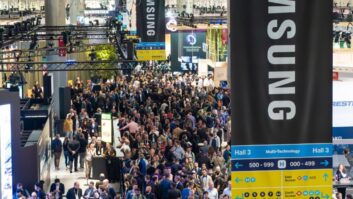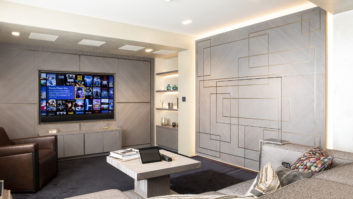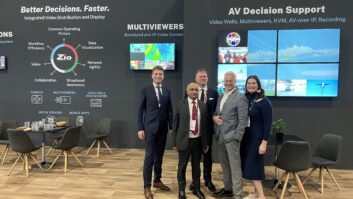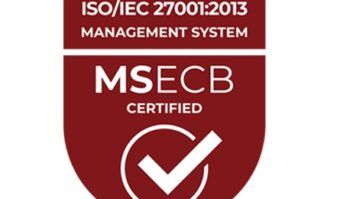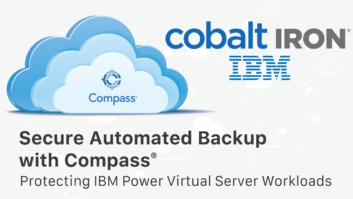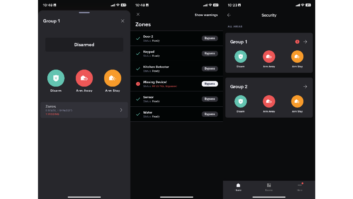 The global pandemic acted as a kind of accelerant: a lot of behaviours – and their attendant technologies – that were present prior to the spread of the virus grew rapidly as Covid ’s impact spread. As we move toward a post-Covid world, there are three things that’ll remain paramount when we talk about commercial AV solutions: interoperability, the management of your ecosystem, and ensuring that the system’s secure. Here’s what dealers need to think about regarding each of these aspects as emerging technologies become standard.
The global pandemic acted as a kind of accelerant: a lot of behaviours – and their attendant technologies – that were present prior to the spread of the virus grew rapidly as Covid ’s impact spread. As we move toward a post-Covid world, there are three things that’ll remain paramount when we talk about commercial AV solutions: interoperability, the management of your ecosystem, and ensuring that the system’s secure. Here’s what dealers need to think about regarding each of these aspects as emerging technologies become standard.
SIMPLE TOUCH
Take, for example, wireless connectivity. Early on in the lockdowns, no one wanted to touch something as simple as a cable for fear of picking up a disease. While we’ve learned that’s not how the virus spreads, the desire for wireless solutions remained. With the need for systems to be able to handle a wide variety of devices and platforms – with everyone from remote workers to BYOD guests – installers and designers of AV systems begin to realise the need for them to handle whatever a client asked.
AV over IP solutions have been gaining enormous traction, and those technologies are a distinct help in this regard. First and foremost, AV over IP is more cost efficient than older solutions. Unlike legacy-based matrix switching solutions with ‘black boxes’ that can rapidly become obsolescent, AV over IP technologies are designed so that basic firmware updates can deliver the features your clients’ need without replacing devices. (This is especially helpful in a world facing a growing supply-chain problem – hardware’s simply getting tougher to come by.)
Additionally, one of the biggest outcomes we can expect to see in a post-Covid world is the coming explosion of managed services. It’s critical for a dealer to expand their thinking on what those contracts could include – one could even make the argument that within an AV over IP framework, those aforementioned firmware updates could be rolled into ongoing service models.
Asset lifecycles are key to this equation: think about all the potential devices, displays, and signage a large client might have. They likely weren’t all plugged in on the same day. Newer displays and devices are coming online constantly, and inevitably, your client’s IT department is going to start seeing a lot of traffic to the ‘help desk’ inbox.
The ticket here is changing your environment from a reactive model
(“I plugged it in and it doesn’t work”)
to a prescriptive model. Suppose you could run systems overnight to check
for rooms that are non-functional and provide the client with a report in the morning that might say, for example: “Conference Room Three is down — a transmitter has failed.” That scenario is preferable — and vastly more cost-effective — than a client company’s CEO attempting to share content during an all-staff meeting and discovering the room’s not working as it should. (Again, a solution such as this could be a component of a dealer’s new-and-improved service contract.)
There are several variables at work here. One is content security: Is it encrypted? Is it secure? Is it safe? No matter what you’re sharing – or where you’re sharing it from – are the eyes on that content all people you trust? That leads us to the two other aspects that are of concern: device access and user access. When a BYOD situation arises, your client won’t necessarily know where that non-native device has been. Lastly, are those ‘eyes-only’ devices protected in a manner so that unwanted third parties are kept away? Are the right protocols in place so that there’s not a breach?
The pandemic has also taught us this: every corporation, every school, every enterprise, now understands how important it is to create a positive culture. It’s especially evident now in the face of what’s come to be called ‘the great resignation’ – employee retention has become a challenge for many firms. One of the things that’s often overlooked is the impact that all this technology can have on a company’s culture. As these systems are designed and installed, integrators and their clients need to ask themselves: are our remote workers having the same collaborative experience as those in the office? Can we leverage the technology we have to see to it that each and every employee feels connected? When that’s happening, the sense of a genuine ‘team’ is reinforced – and everyone becomes inevitably more productive as a result.
